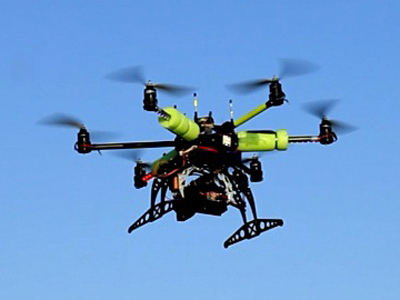Flashy and Illegal, Drones Change the Commercial Real Estate Game
By Jotham Sederstrom August 29, 2013 2:00 pm
reprintsOver the past few months, tiny robots utilizing unmanned aerial vehicle, or UAV, drone technology to get aerial views and panoramic video of various residential properties have been generating quite a bit of buzz.
Essentially, people with money to spend on high-end real estate don’t just want the space itself to be flashy, but the presentation as well.
 “This technology is an exciting sales tool, because it can hype up the property, showcase the surrounding location and provide reassurance of the structural integrity of hard-to-reach areas like the roof,” said Richard Savoie, founder of Engineers Looking for Stuff, a social networking site for engineers that features a UAV forum for the discussion of drones and other aerial technology.
“This technology is an exciting sales tool, because it can hype up the property, showcase the surrounding location and provide reassurance of the structural integrity of hard-to-reach areas like the roof,” said Richard Savoie, founder of Engineers Looking for Stuff, a social networking site for engineers that features a UAV forum for the discussion of drones and other aerial technology.
“But really, it just comes down to fun and flash,” he continued. “If you see property on a video from a robot, it just looks extra cool. Some trends may not be practical, but they’re stylish.”
So will drones be honing in on the commercial side of things anytime soon?
Jonathan Wasserstrum, founder and CEO of TheSquareFoot, an online platform that helps companies find and lease office space and provides video tours for their clients, believes the only foreseeable advantage in the commercial world will be a financial one.
“It might be cheaper to get these aerial shots done with a drone than if you hired someone to do it from a helicopter,” Mr. Wasserstrum speculated. “Also, if drones can do things a regular helicopter can’t, like provide certain views, that could be an advantage, too.”
Right now, there are a few boutique firms popping up specifically to serve this market in New York and elsewhere, though it’s not exactly legal.
“Because there’s a lack of regulation for commercial drone use in the U.S., it’s technically illegal,” Mr. Savoie said. “The process requires clearance from the Federal Aviation Administration, which is too costly and burdensome for most operators. However, some very zealous companies have made it work. In New York, it’s SkyCam.”
While most companies using the technology in the U.S. are doing so illegally, the amount of commercial licenses the FAA has been doling out has steadily doubled each year since 2009.
“Soon, it will absolutely be standard for property over $1 million to have flyover footage, and don’t expect the lack of FAA guidance to slow this down at all,” Mr. Savoie said.
However, Mr. Wasserstrum estimates that it’s still early to expect these tiny, flying robots to invade the commercial market.
“Most landlords in the commercial industry are generally five to 10 years behind the residential, so, if drones are just starting to be used there, we can probably expect to see them on the commercial side in the 2020s,” Mr. Wasserstrum said.



